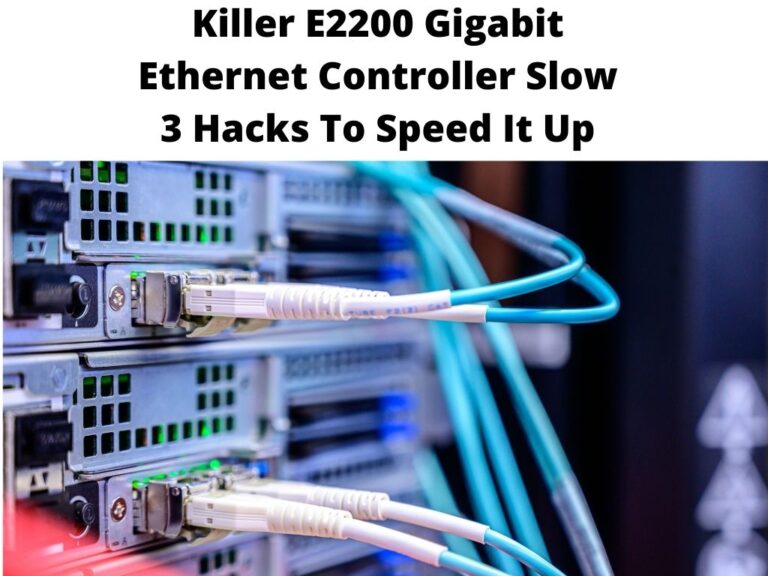

- #KILLER E2200 GIGABIT ETHERNET CONTROLLER NO CONNECTION DRIVERS#
- #KILLER E2200 GIGABIT ETHERNET CONTROLLER NO CONNECTION DRIVER#
- #KILLER E2200 GIGABIT ETHERNET CONTROLLER NO CONNECTION SOFTWARE#
- #KILLER E2200 GIGABIT ETHERNET CONTROLLER NO CONNECTION TORRENT#
- #KILLER E2200 GIGABIT ETHERNET CONTROLLER NO CONNECTION WINDOWS#
#KILLER E2200 GIGABIT ETHERNET CONTROLLER NO CONNECTION DRIVER#
Qualcomm eventually relented and now offers a barebones version of the Atheros LAN and Wi-Fi driver set without the manager included. While competing gaming network managers exist, such as ASUS’s GameFirst, now on its third iteration, don’t expect much better results as all of these solutions share the same external bandwidth limitations that hinder Doubleshot.įortunately, there are alternatives.
#KILLER E2200 GIGABIT ETHERNET CONTROLLER NO CONNECTION SOFTWARE#
Besides questionable test results, the software has a long history of annoying users, and while newer packages have filed off some of the sharp edges, I still experienced settings that would not retain changes after reboot and network rules that applied arbitrarily. Is the Killer Network Manager worth it, as a deluxe feature? Despite claims and plenty of promise, no. That generally means Intel, which has the resources to sweat the details. If you’re looking to make a difference in performance with your networking card, low-DPC-latency solutions are where you’ll find it. This results in drop-outs in audio or video, even when plenty of CPU time and bandwidth are otherwise available.
#KILLER E2200 GIGABIT ETHERNET CONTROLLER NO CONNECTION DRIVERS#
Inefficient drivers co-opt other devices’ DPC time from the single, cooperatively multitasked queue that each CPU is permitted in Windows. Killer drivers are a little messy with DPC control, and use up more CPU time as a result. Intel Ethernet controller on the left, Doubleshot on the right. Badly written drivers can stall an otherwise smoothly operating set of real-time tasks, which are handled by Deferred Procedure Calls (DPC) at the kernel level.
#KILLER E2200 GIGABIT ETHERNET CONTROLLER NO CONNECTION WINDOWS#
Even the mightiest 8-core Intel desktop systems have to deal with an inherent limitation of the Windows task management structure. So if you can’t stack multiple controllers to improve performance, what can you do? The answer is pretty mundane, and it comes down to drivers.Īlthough they aren’t as sophisticated as Intel’s offerings, the real problem here isn’t the Atheros hardware, it’s the driver sitting on top of it.

While networking behemoth Cisco won’t have any sleepless nights, hapless users have already experienced plenty, with support boards packed with problems that all amounted to the same answer-turn it off. But balancing between asymmetric networking interfaces is notoriously difficult, often causing more problems than it solves, and testing the Killer network manager revealed this remains the case. Yes, you may be able to slightly reduce the load on your wired connection by shunting secondary data over to wi-fi, if you're running background processes.
#KILLER E2200 GIGABIT ETHERNET CONTROLLER NO CONNECTION TORRENT#
In any case, torrent packages also offer effective bandwidth controls of their own.Īnother issue is the mixture of Wi-Fi and wired Ethernet. Torrenting files while playing a shooter or MOBA is ill-advised if you care about performance, and it’ll probably be reflected in your own ping and your score at the end of a match. Since a single network process can’t be split between multiple controllers, these solutions presuppose a gamer is running multiple bandwidth-intensive processes in the background that need sharing in the first place, a habit that strategy or casual gamers may employ but almost all performance gamers avoid. No, your ISP isn’t going to suddenly get any faster because you have a new motherboard. You can’t pull more bandwidth than your server or network can push.Įthernet vs DoubleShot internet results. Even on a LAN, most router ports are limited to the speed of gigabit Ethernet as are the local servers' Ethernet cards themselves. How is it possible that in this ideal environment, improvements were so difficult to find? The reality is that bandwidth limitations outside the computer, and thus control of the Killer Network Manager, are almost always responsible for the bottlenecks in online gaming.įor example, ISP speeds are just a fraction of home network bandwidth or a server attached to a network with a single gigabit NIC (gigabit fiber is as fast as it gets for most, and your typical cable or DSL connection is far slower at 100 megabits or less). Where’s the performance? What’s really going on? Both Left for Dead 2 and CS:GO show no dramatic differences in server ping times or gaming experience beyond normal network variation. Gaming results in the real world shadowed the benchmarks closely. This predictably results in slower overall operation and produces some embarrassing results, especially in general use, with no measurable advantages gained in return. When run with the latest downloaded rules, network file copy operations are shunted to Wi-Fi in a fruitless quest to preserve network speed, even when no high-priority network tasks are in evidence. That exception wasn’t a flattering one either. Without rule adjustments, file copy operations get routed off to Wi-Fi where they languish at low speeds.


 0 kommentar(er)
0 kommentar(er)
